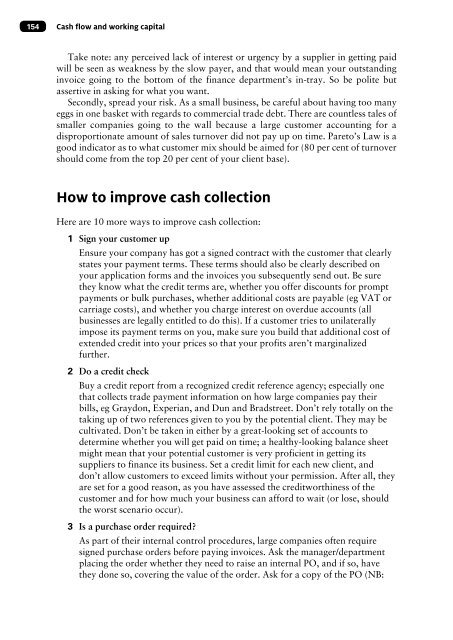The growing business handbook : inspiration and advice ... - Sparkler
The growing business handbook : inspiration and advice ... - Sparkler
The growing business handbook : inspiration and advice ... - Sparkler
Create successful ePaper yourself
Turn your PDF publications into a flip-book with our unique Google optimized e-Paper software.
154 Cash flow <strong>and</strong> working capital<br />
Take note: any perceived lack of interest or urgency by a supplier in getting paid<br />
will be seen as weakness by the slow payer, <strong>and</strong> that would mean your outst<strong>and</strong>ing<br />
invoice going to the bottom of the finance department’s in-tray. So be polite but<br />
assertive in asking for what you want.<br />
Secondly, spread your risk. As a small <strong>business</strong>, be careful about having too many<br />
eggs in one basket with regards to commercial trade debt. <strong>The</strong>re are countless tales of<br />
smaller companies going to the wall because a large customer accounting for a<br />
disproportionate amount of sales turnover did not pay up on time. Pareto’s Law is a<br />
good indicator as to what customer mix should be aimed for (80 per cent of turnover<br />
should come from the top 20 per cent of your client base).<br />
How to improve cash collection<br />
Here are 10 more ways to improve cash collection:<br />
1 Sign your customer up<br />
Ensure your company has got a signed contract with the customer that clearly<br />
states your payment terms. <strong>The</strong>se terms should also be clearly described on<br />
your application forms <strong>and</strong> the invoices you subsequently send out. Be sure<br />
they know what the credit terms are, whether you offer discounts for prompt<br />
payments or bulk purchases, whether additional costs are payable (eg VAT or<br />
carriage costs), <strong>and</strong> whether you charge interest on overdue accounts (all<br />
<strong>business</strong>es are legally entitled to do this). If a customer tries to unilaterally<br />
impose its payment terms on you, make sure you build that additional cost of<br />
extended credit into your prices so that your profits aren’t marginalized<br />
further.<br />
2 Do a credit check<br />
Buy a credit report from a recognized credit reference agency; especially one<br />
that collects trade payment information on how large companies pay their<br />
bills, eg Graydon, Experian, <strong>and</strong> Dun <strong>and</strong> Bradstreet. Don’t rely totally on the<br />
taking up of two references given to you by the potential client. <strong>The</strong>y may be<br />
cultivated. Don’t be taken in either by a great-looking set of accounts to<br />
determine whether you will get paid on time; a healthy-looking balance sheet<br />
might mean that your potential customer is very proficient in getting its<br />
suppliers to finance its <strong>business</strong>. Set a credit limit for each new client, <strong>and</strong><br />
don’t allow customers to exceed limits without your permission. After all, they<br />
are set for a good reason, as you have assessed the creditworthiness of the<br />
customer <strong>and</strong> for how much your <strong>business</strong> can afford to wait (or lose, should<br />
the worst scenario occur).<br />
3 Is a purchase order required?<br />
As part of their internal control procedures, large companies often require<br />
signed purchase orders before paying invoices. Ask the manager/department<br />
placing the order whether they need to raise an internal PO, <strong>and</strong> if so, have<br />
they done so, covering the value of the order. Ask for a copy of the PO (NB:








